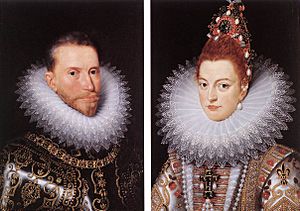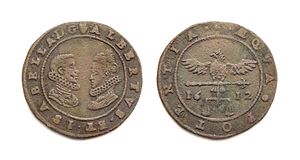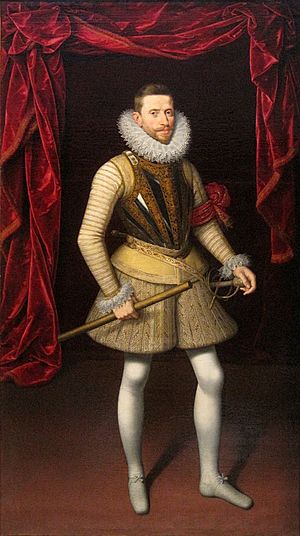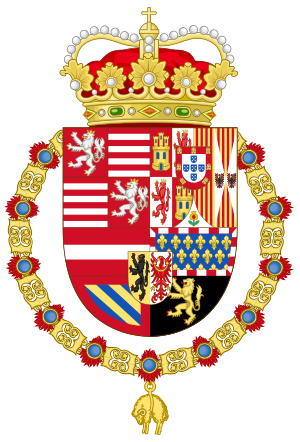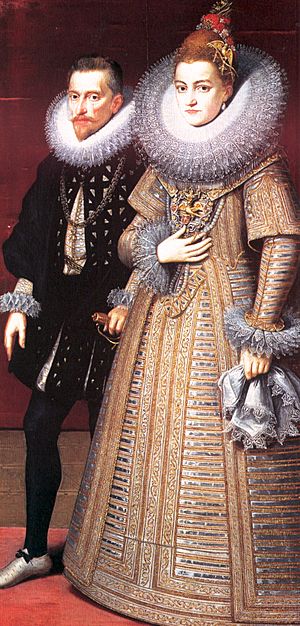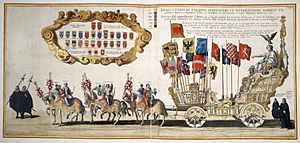Albert VII, Archduke of Austria facts for kids
Quick facts for kids Albert (VII) |
|
|---|---|

|
|
| Sovereign of the Netherlands Duke of Lothier, Brabant, Limburg, Luxembourg, and Guelders Margrave of Namur Count Palatine of Burgundy< Count of Flanders, Artois, and Hainaut |
|
| Reign | 6 May 1598 – 13 July 1621 |
| Predecessor | Philip II |
| Successor | Philip IV |
| Co-monarch | Isabella Clara Eugenia |
| Archduke of Lower and Upper Austria | |
| Reign | 20 March – 9 October 1619 |
| Predecessor | Matthias |
| Successor | Ferdinand II |
| Viceroy of Portugal | |
| Reign | 11 February 1583 – 5 July 1593 |
| Predecessor | Duke of Alba |
| Successor | 1st Regency Council |
| Monarch | Philip I of Portugal |
| Born | 13 November 1559 Wiener Neustadt |
| Died | 13 July 1621 (aged 61) Brussels |
| Burial | St. Michael and St. Gudula Cathedral |
| Spouse | |
| House | Habsburg |
| Father | Maximilian II, Holy Roman Emperor |
| Mother | Maria of Spain |
| Religion | Roman Catholicism |
| Signature |  |
Albert VII (German: Albrecht VII; born November 13, 1559 – died July 13, 1621) was an important ruler from the House of Habsburg. For a short time in 1619, he was the Archduke of Austria. More famously, he ruled the Habsburg Netherlands (which included parts of modern-day Belgium, Luxembourg, and the Netherlands) with his wife, Isabella Clara Eugenia, from 1598 to 1621.
Before becoming a ruler, Albert had a career in the Catholic Church. He was a cardinal and also served as the Viceroy of Portugal. He also held the title of Governor General of the Habsburg Netherlands before becoming its sovereign. His time as Archduke of Austria was very brief, lasting only a few months.
Contents
Early Life and Career
Albert was born in 1559. He was the fifth son of Maximilian II, Holy Roman Emperor, who was the Holy Roman Emperor. His mother was Maria of Spain, daughter of Charles V, Holy Roman Emperor.
When Albert was just eleven years old, he was sent to the Spanish royal court. His uncle, Philip II of Spain, took charge of his education. Albert was considered very intelligent. Initially, he was expected to become a church leader.
In 1577, at the age of eighteen, he was made a cardinal by Pope Gregory XIII. He was meant to become the Archbishop of Toledo, but the current archbishop lived longer than expected. Albert never became a priest or bishop, and he gave up his church titles in 1598. His early training in the church, however, influenced his way of life.
In 1583, after Spain and Portugal united, Albert became the first Viceroy of Portugal. This meant he was the king's representative in Portugal and its overseas territories. He helped organize the Spanish Armada in 1588. He also successfully defended Lisbon from an English attack in 1589. In 1593, King Philip II called him back to Madrid, where Albert played a key role in the Spanish government.
Ruling the Habsburg Netherlands
In 1595, Albert was sent to Brussels to become the Governor General of the Habsburg Netherlands. This was after his older brother, Archduke Ernest, passed away. Albert arrived in Brussels on February 11, 1596.
His main goal was to improve Spain's military strength in the Low Countries. Spain was fighting against the Dutch Republic, England, and France. Spain had faced many defeats since 1590. In his first military campaign, Albert surprised his enemies by capturing Calais and Ardres from the French. He also took Hulst from the Dutch.
However, Spain faced financial problems later that year. This led to military setbacks in 1597. The Dutch leader, Maurice of Nassau, Prince of Orange, captured Spanish strongholds. The Spanish also lost the city of Amiens to Henry IV of France. With no money to pay the soldiers, Albert also dealt with many mutinies (when soldiers rebel against their commanders).
While fighting the war, Albert also tried to make peace. Only the French King was willing to negotiate. With the help of a church leader, Spain and France signed the Peace of Vervins in May 1598. Spain gave back its captured lands, and France left the war. However, France continued to support the Dutch Republic financially.
Just a few days after the treaty, on May 6, 1598, King Philip II announced a big decision. He would marry his oldest daughter, Isabella Clara Eugenia, to Albert. He would also give them control over the Habsburg Netherlands. The agreement stated that if Albert and Isabella had no children, the Netherlands would return to Spain. It also had secret rules that kept the Spanish army in the region.
Albert officially gave up his cardinal title on July 13, 1598. He left for Spain on September 14, not knowing that King Philip II had died the night before. Albert and Isabella were married in Valencia on April 18, 1599.
Years of War and Truce
The first half of Albert and Isabella's rule was dominated by war. They tried to make peace with the United Provinces and Queen Elizabeth I of England, but it didn't work. The goal was to regain military strength and isolate the Dutch Republic. Albert believed it would be very hard to conquer the northern provinces again.
Albert's reputation as a military leader suffered when he was defeated by the Dutch leader, Maurice of Nassau, prince of Orange, at the battle of Nieuwpoort in 1600. His long siege of Ostend (1601–1604) also did not go well. After this, a new general, Ambrogio Spínola, took over military operations. Spínola eventually forced Ostend to surrender in 1604.
Meanwhile, a new king, James I, came to power in England. This opened the way for a separate peace treaty with England. In 1604, England, Spain, and the Archducal Netherlands signed the Treaty of London. This helped bring peace, even though religious differences caused some tension.
Spínola's military actions and the threat of being isolated made the Dutch Republic agree to a ceasefire in 1607. After long talks, the warring parties signed the Twelve Years' Truce in Antwerp in 1609. This agreement recognized the United Provinces as a sovereign (independent) power for the duration of the truce. Albert worked hard to convince King Philip III of Spain to agree to this. When Philip finally approved, Albert's efforts for peace in the Low Countries finally succeeded.
Years of Peace and Progress
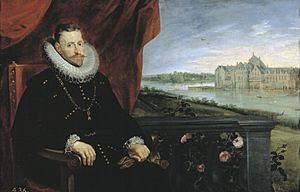
The years of the Twelve Years' Truce gave the Habsburg Netherlands a much-needed break. Farmers could safely work their fields again. Albert and Isabella's government encouraged reclaiming land that had been flooded during the wars. They also supported draining marshy areas to create new farmland. This recovery in farming led to a small increase in the population after many years of decline.
Industries, especially luxury goods, also began to recover. However, international trade was still difficult because the Scheldt river was closed. The government planned to build canals to bypass this blockade. They also supported the creation of public pawn shops, called Monti di Pietà, to help people in poverty.
During this time, Albert and Isabella also worked to strengthen the Catholic Reformation in the Habsburg Netherlands. Most Protestants had already left the Southern Netherlands. Those who remained were not actively persecuted after 1597. Laws passed in 1609 allowed them to be present, as long as they did not worship in public. Religious debates were also forbidden.
The rulers strongly supported new and reformed religious orders. The Jesuits received the most money, allowing them to build impressive churches in Brussels and Antwerp. Other Catholic groups, like the Capuchins, also received significant funds. Albert and Isabella's personal efforts led to the creation of the first Discalced Carmelites convents in the region, showing their strong Spanish Catholic beliefs.
Albert and Isabella's rule also saw an increase in the power of the prince in the Habsburg Netherlands. The States General (a kind of parliament) of the loyal provinces was only called once in 1600. After that, the government preferred to deal directly with the provinces. The years of peace allowed the rulers to pass many new laws. For example, the "Eternal Edict" of 1611 reformed the justice system. Other laws dealt with money, the nobility, duels, and gambling.
Albert also became involved in European politics. In 1614, he intervened in a dispute over land in Germany. This event was a preview of the Thirty Years' War that was to come. After the Defenestration of Prague (an event that helped start the Thirty Years' War), Albert sent troops to support his cousin, Ferdinand II, Holy Roman Emperor. He also pushed King Philip III for financial help for the Austrian Habsburgs. His actions greatly contributed to the victory of the Habsburg forces in the Battle of the White Mountain in 1620.
Death and Succession
Albert and Isabella Clara Eugenia had three children, but they all died very young (in 1605, 1607, and 1609). As they got older, it became clear they would not have more children. When Albert's health worsened in 1613–1614, plans were made for Philip III of Spain to become the next ruler, according to the original agreement. The provinces swore to accept the King as the heir between 1616 and 1617. However, Philip III died before Albert, in March 1621. The right to rule then passed to Philip III's oldest son, Philip IV of Spain.
Albert's health got much worse in late 1620. The Twelve Years' Truce was set to end in April of the next year. He spent his last efforts trying to get the truce renewed. He was willing to make many compromises to achieve this. However, neither Spain nor the Dutch Republic took his pleas for peace seriously. Albert died on July 13, 1621, which was around the same time that the fighting started again.
Supporting the Arts
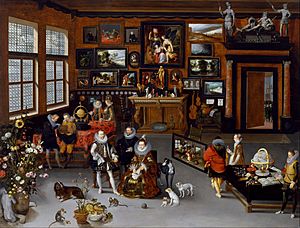
Not much remains of Albert and Isabella Clara Eugenia's palaces today. Their grand art collections were spread out after 1633, and many pieces have been lost. Still, Albert and Isabella are well-known for supporting the arts.
They are probably best remembered for hiring Peter Paul Rubens as their court painter in 1609. They also commissioned works from other famous painters like Frans Pourbus the Younger, Otto van Veen, and Jan Brueghel the Elder. They also supported architects like Wenzel Cobergher and Jacob Franquart, and sculptors like the de Nole family.
One of the best-preserved examples of art from their time is at Scherpenheuvel. Albert and Isabella directed Cobergher, the painter Theodoor van Loon, and the de Noles to create a pilgrimage church in a planned city there.
Titles
As co-sovereigns of the Habsburg Netherlands, their full title was: "Albert and Isabella Clara Eugenia, Infanta of Spain, by the grace of God Archdukes of Austria, Dukes of Burgundy, Lothier, Brabant, Limburg, Luxembourg and Guelders, Counts of Habsburg, Flanders, Artois, Burgundy, Tyrol, Palatines in Hainaut, Holland, Zeeland, Namur and Zutphen, Margraves of the Holy Roman Empire, Lord and Lady of Frisia, Salins, Mechlin, the City, Towns and Lands of Utrecht, Overijssel and Groningen".
See Also
 In Spanish: Alberto de Austria para niños
In Spanish: Alberto de Austria para niños


